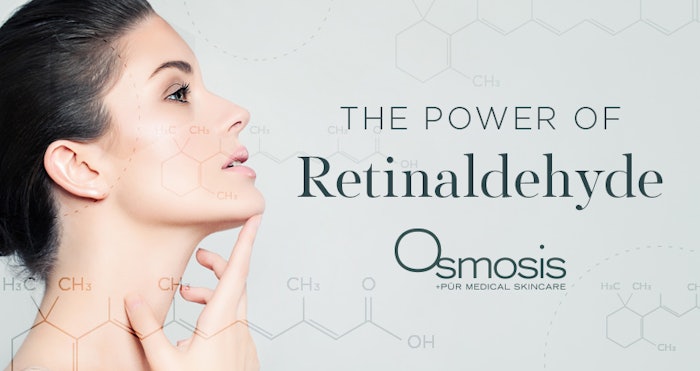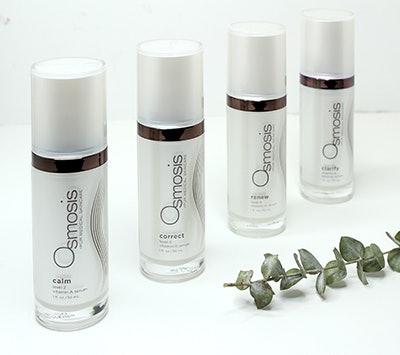
It is no secret that vitamin A is a key ingredient in skin care. Its remarkable ability to reverse aging, increase nutrients and encourage the production of collagen and elasticity in the skin is unmatched. With so many different forms of the vitamin A molecule, it can be difficult and overwhelming to decipher what is best for our skin. Not to mention the stigma that comes along with vitamin A serums that can make us hesitant to use them. From sun-sensitivity, to redness and irritation, finding the right form and the right product becomes even more important. Here at Osmosis, we’ve made it our mission to partner with skin and our unrivaled Retinaldehyde formulation does just that.
 In the body, we convert Beta Carotene into Retinol, Retinol into Retinaldehyde and Retinaldehyde into Retinoic Acid. All of these vitamin A derivatives have important and proven activity in the skin, but because of the size of the molecule, they struggle to penetrate the epidermis when applied topically, resulting in the irritation and sun-sensitivity that can come with using certain forms of vitamin A. However, research has shown that Retinaldehyde and Retinoic Acid are 500 times more active than their vitamin A counterparts (Beta Carotene and Retinol), meaning smaller amounts can be used and absorbed into the skin to achieve those skin-smoothing results. Why Retinaldehyde over Retinoic Acid? Once the skin converts Retinaldehyde to Retinoic Acid, it cannot be converted back into a form of vitamin A that can be stored. So, though it may penetrate the epidermis, the skin converts only enough to perform the desired function and leaves the rest in storage forms, and Retinoic Acid cannot be stored by the body, which means applying topical Retin-A can result in two things: irritation from over-stimulation and over-exfoliation. Retinaldehyde, in addition to having its own receptor activity, is the immediate precursor of Retinoic Acid, so the skin will convert a significant amount to that form upon application without the overstimulation because the skin is able to regulate the conversion, making only what it needs and storing the rest in adipose tissue.
In the body, we convert Beta Carotene into Retinol, Retinol into Retinaldehyde and Retinaldehyde into Retinoic Acid. All of these vitamin A derivatives have important and proven activity in the skin, but because of the size of the molecule, they struggle to penetrate the epidermis when applied topically, resulting in the irritation and sun-sensitivity that can come with using certain forms of vitamin A. However, research has shown that Retinaldehyde and Retinoic Acid are 500 times more active than their vitamin A counterparts (Beta Carotene and Retinol), meaning smaller amounts can be used and absorbed into the skin to achieve those skin-smoothing results. Why Retinaldehyde over Retinoic Acid? Once the skin converts Retinaldehyde to Retinoic Acid, it cannot be converted back into a form of vitamin A that can be stored. So, though it may penetrate the epidermis, the skin converts only enough to perform the desired function and leaves the rest in storage forms, and Retinoic Acid cannot be stored by the body, which means applying topical Retin-A can result in two things: irritation from over-stimulation and over-exfoliation. Retinaldehyde, in addition to having its own receptor activity, is the immediate precursor of Retinoic Acid, so the skin will convert a significant amount to that form upon application without the overstimulation because the skin is able to regulate the conversion, making only what it needs and storing the rest in adipose tissue.
 Now, let’s talk penetration. The dermal layer of the skin is where the majority of aging occurs; and because of this, deep, thorough penetration is critical for visible results. Using a smaller percentage of Retinaldehyde does assist with its journey into your skin, but we have taken that process a step further. Our unique liposomal delivery system ensures optimal results by coating the retinaldehyde molecule in a liposome called phosphatidylcholine to increase penetration by 600%. This coating mimics the properties of the cells in your body, making it easily recognizable by the skin and body to enhance absorption and boost results.
Now, let’s talk penetration. The dermal layer of the skin is where the majority of aging occurs; and because of this, deep, thorough penetration is critical for visible results. Using a smaller percentage of Retinaldehyde does assist with its journey into your skin, but we have taken that process a step further. Our unique liposomal delivery system ensures optimal results by coating the retinaldehyde molecule in a liposome called phosphatidylcholine to increase penetration by 600%. This coating mimics the properties of the cells in your body, making it easily recognizable by the skin and body to enhance absorption and boost results.
Create permanent, visible change in your clients’ skin. Visit our website to discover more on how our vitamin A is formulated to empower the most results possible.

Disclaimer:
The above paid-for content was produced by and posted on behalf of the Sponsor. Content provided is generated solely by the Sponsor or its affiliates, and it is the Sponsor’s responsibility for the accuracy, completeness and validity of all information included. Skin Inc. takes steps to ensure that you will not confuse sponsored content with content produced by Skin Inc. and governed by its editorial policy.










